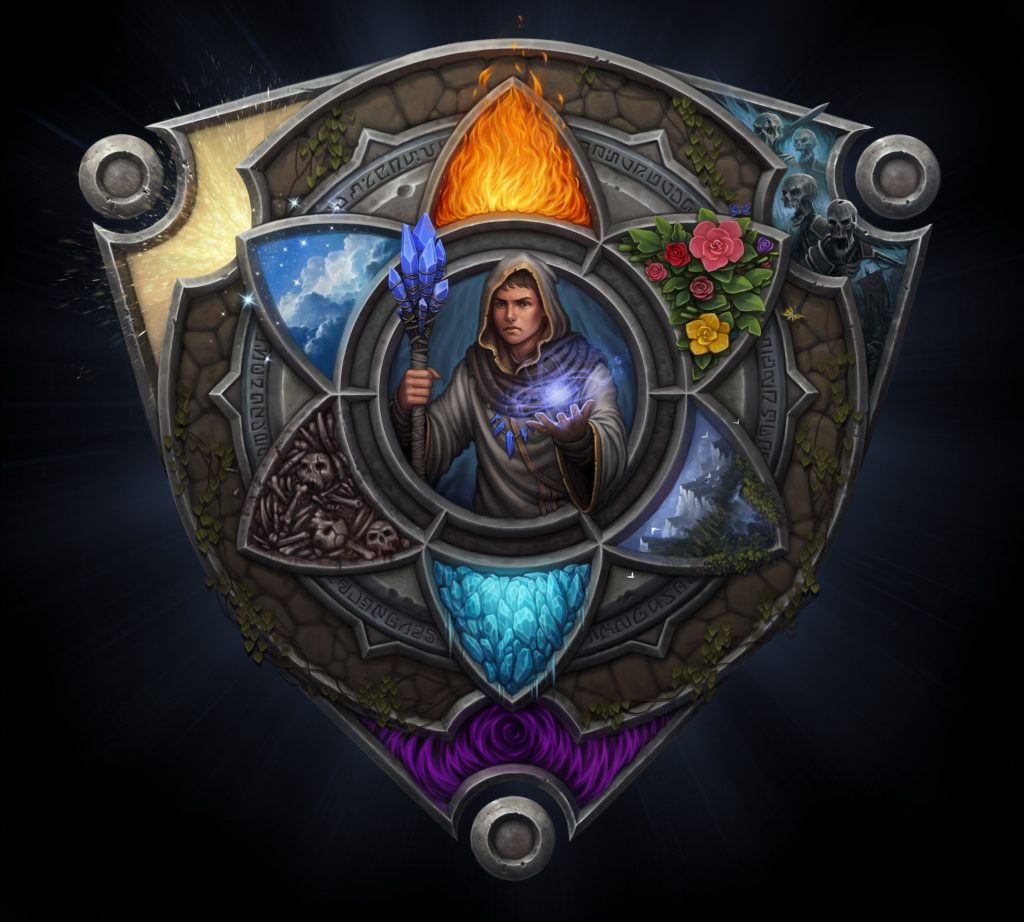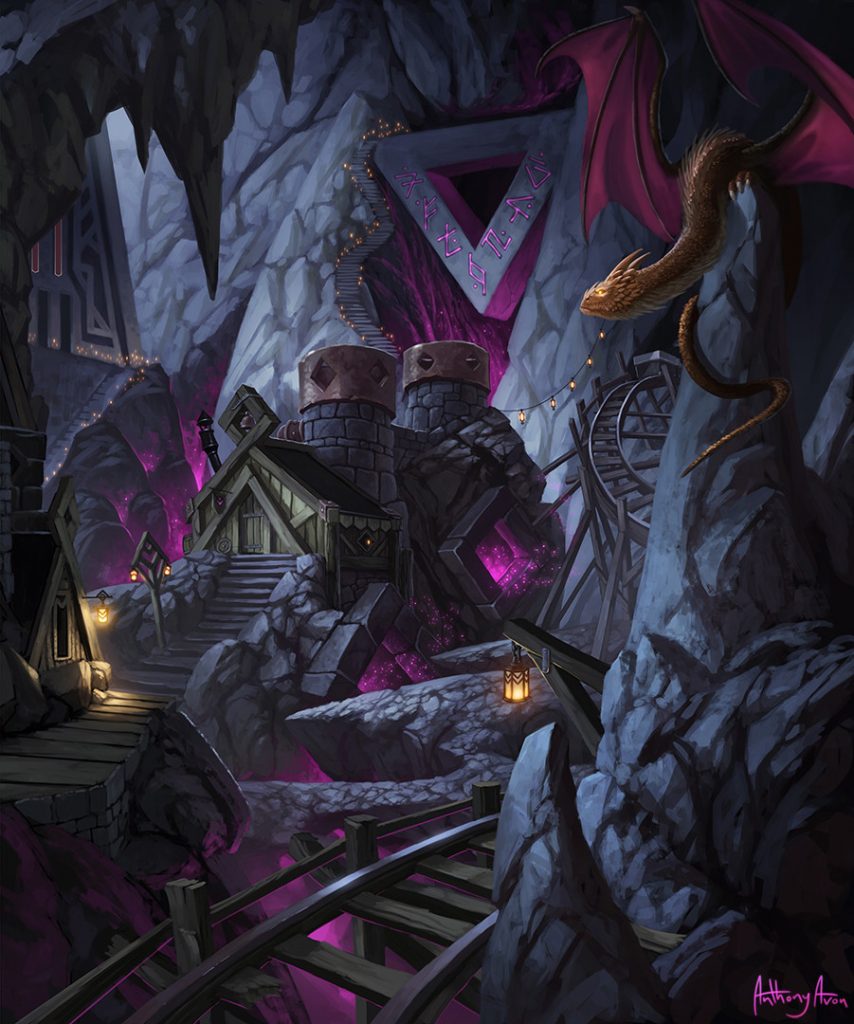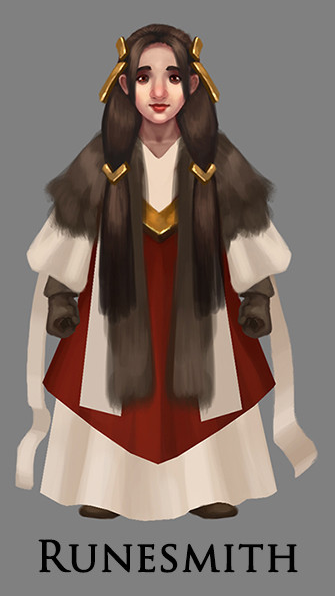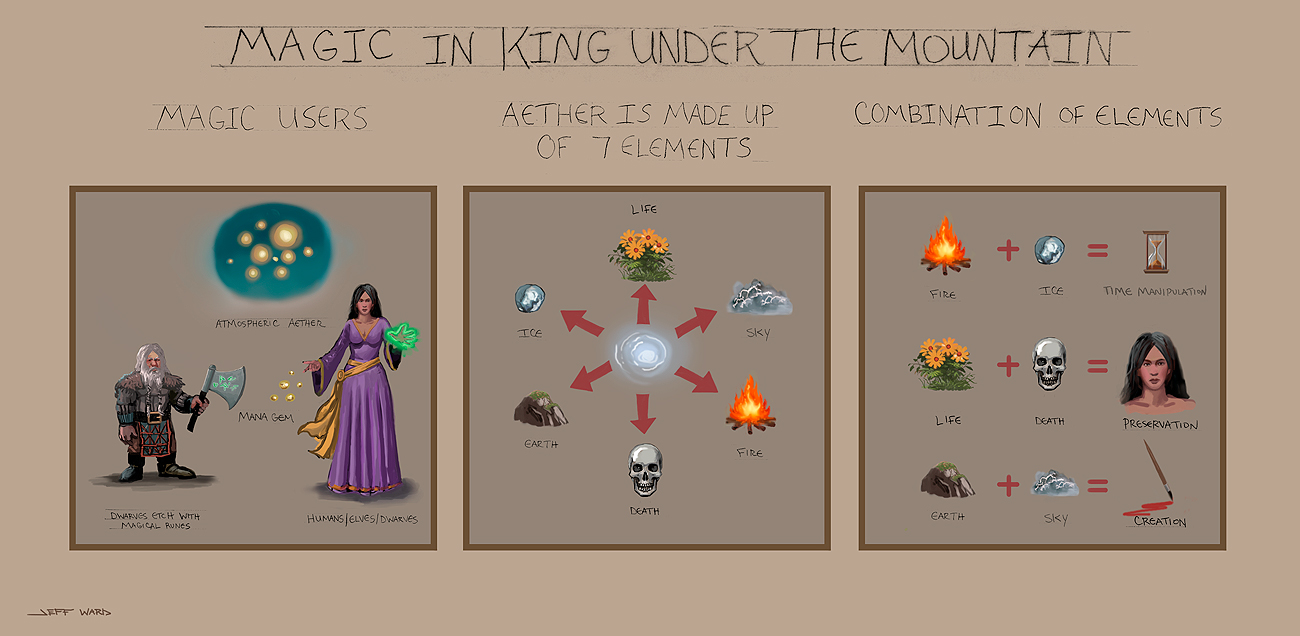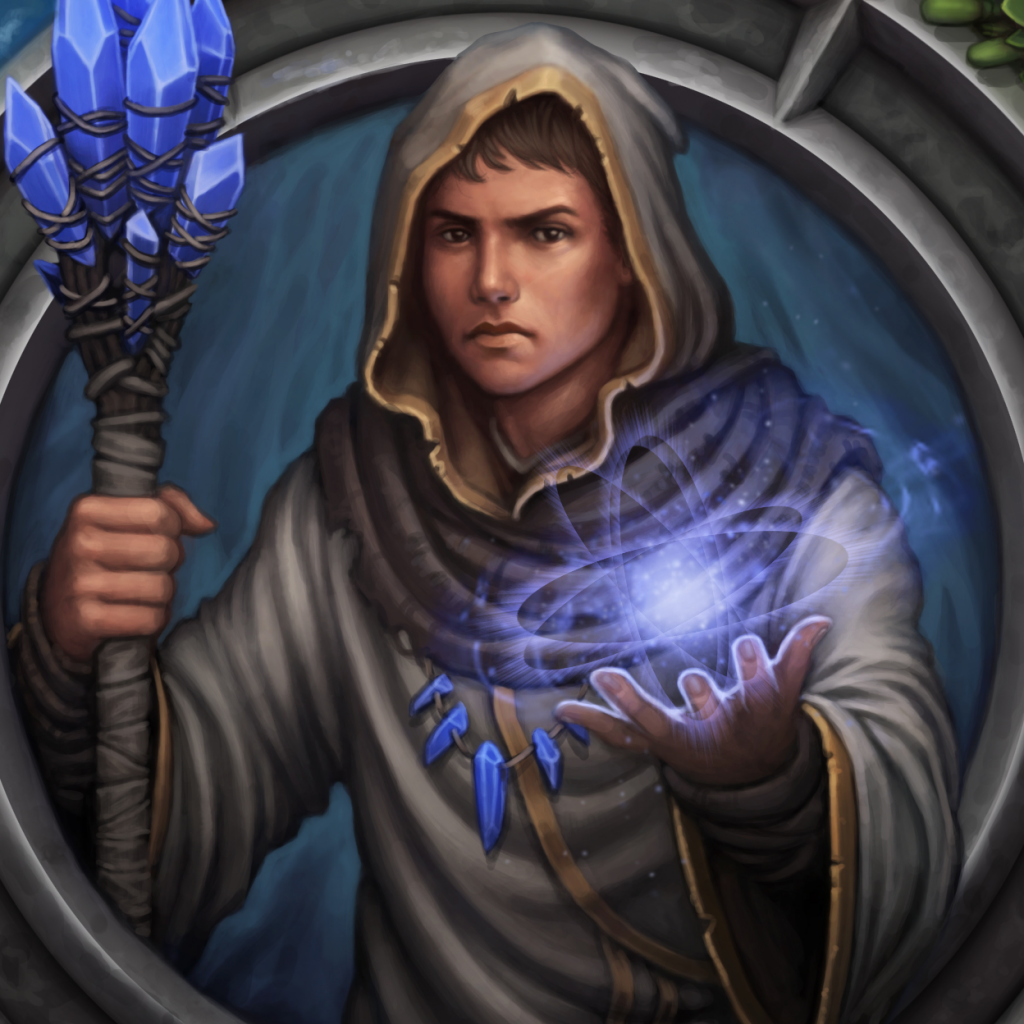We're not just building a game with King under the Mountain, but a whole world with its own lore and history to act as a unique setting. This is the first of several worldbuilding articles which will help design and inspire both the artwork and mechanics of the game. This time, we're going to talk about magic - what it is, how it works, and what it means to your characters.
There's more to the world of King under the Mountain than meets the eye, quite literally. The game takes place in the physical, material world. Invisible to the naked eye, there also exists a spiritual, immaterial reflection of the world known as the Immaterial. These two planes of existence are tied together by a substance known as æther - intangible and external - which permeates the entire world much like air and the wind. Complementing æther, all living creatures and the planet itself contain what is known as mana - a well of spiritual, immaterial energy. Much like yin and yang, these differing yet complementing essences can be combined to produce magic - fantastic displays of power produced by harnessing the energy of æther and mana in tandem.
Mana and Æther
Although all living things hold a store of mana within themselves, only a few are able to tap into this well and harness its power. Even then, it's a very rare individual that has the natural talent to instinctively combine æther with mana to produce magical effects. More commonly, those with the potential to see and manipulate æther and mana require some level of training and guidance to make use of their abilities.
In the world of King under the Mountain, just as much happens beneath the surface as on top of it. Just as living creatures keep a store of mana within themselves, so does the planet too. This phenomenon manifests itself as "mana gems", precious gemstones which glow brightly from an inner light. Rare and extremely valuable, these gems are found and mined primarily in areas with a high concentration of æther.
While a mage combines the mana within themselves with aether to produce magic, they can also draw on mana stored within gems close to them to offset some of the cost of their own mana supply. As a mage accumulates experience of using magic from a combination of their own mana and the mana stored within nearby mana gems, they're able to increase the proportion of "external mana", thereby increasing their overall mana pool. While inexperienced magicians tend to require an equal mix of inner mana and external æther, those with more experience are able to mix a smaller amount of their own mana to produce the desired effect. A knowledgeable magic user with a collection of “charged” mana gems is able to create much larger and more powerful magical effects due to being able to call on a much larger supply of external mana and æther.
Drawing mana from the user or a mana gem depletes the reserve of æther stored within. As a magic user depletes their reserve, they’ll no longer be able to cast any magic - even having access to further mana gems is no use if the user has no mana of their own. Depleted reserves of mana are naturally restored over time as æther flows over the land. This is dependent on the concentration and speed of the flow of æther in the local area, so a magic user usually has no options to speed up or slow down this process. Sometimes it will happen relatively quickly, and other times, when there is a distinct lack of æther in the area, it will not happen at all until the “wind” picks up.
Runesmithing
While humans, elves and orcs all have the potential to use magic as described here, dwarves (uniquely) were created primarily from Earth instead of æther and because of this, are not able to cast magic themselves. Instead, the dwarves apply their mastery of metalwork and jewellery to apply mystic runes to weapons and other equipment which imbues them with magical effects and abilities. These runes are created and etched by dwarven runesmiths using infused mana gems as a base resource which get processed and turned into a metallic-looking inlay onto the blade of a weapon or piece of armour. To become a runesmith takes many years of study and only the largest and most prosperous dwarven settlements can attract their skills (Attracting and employing a runesmith is one of the later gameplay goals for the player managing a dwarven settlement).
The Elements
Æther is made up of 7 elements. Fire and Ice, Life and Death, Earth and Sky, and Æther as an element itself, usually called Spirit. Most of these are opposed elements that tend to cancel each other out - Fire opposes Ice, Life opposes Death and Earth opposes Sky. Spirit binds the rest of the elements together.
Most usage of magic tends to be a manifestation of one of these elements: a blast or wave of Fire or Ice; enhanced healing or growth with Life - or the opposite with Death; while Earth can't create something from nothing (by itself) it can transform materials from one thing to another, and Air is often used to move things around magically. In addition to the more common mana gems containing a well of æther or Spirit, there exist more rare elemental mana gems infused exclusively with one of the other six elements.
While a beginning magic user may only be skilled with a single element (in addition to Spirit), over time and experience this will grow to include other elements, potentially all of them although this is rare.
When a magic user has the aptitude for more than one element, with even more skill they may have the ability to combine two or more elements to produce more unusual effects, the number of which would be too many to list here. For example, a wizard may be able to combine Life and Earth to create a living golem of stone to do their bidding. For darker purposes, Death and Fire usually combine to create witchfyre, a dangerous black/purple flame which spreads uncontrollably, but is necessary in the forging of some magical metals.
Usually, attempting to blend together two opposing elements cancels them out. This is usually used beneficially - using Ice to put out a fire, even a magical one, works almost instantly if applied correctly. However, the most skilled magic users are able to combine two opposing elements just right so that they don’t annihilate each other, but instead blend together to give more powerful effects not possible otherwise (which you can see hinted at in the top illustration).
Mages and spellcraft
The simplest magical spells are created by drawing on ones own mana reserve and blending this with one of the elements from the nearby aæther. More complex spells are cast by drawing on several elemental “threads” at once and blending these together in just the right way and quantity. Finding these blends or recipes is a very time consuming task so most mages keep extensive notes on their research and experiments. These tend to be guarded jealously, but if a mage gains access to the knowledge of another, they can increase their mastery and power much more quickly than working on their own. It's for this reason that less ambitious mages are usually content to put up with the strict rules of a magical place of learning to expand their knowledge. Designer's note - one of the larger stretch goals for King under the Mountain is a mode where you play as a human wizard or necromancer, controlling a single avatar character while you use magical constructs and golems to build up your lair while you improve your knowledge and experience of spells.
Orcs and shamans
While humans and elves have to apply a lot of learning to use magic, and dwarves can’t cast magic but instead inscribe runes for magical abilities, orcs do neither of these. Instead, some orcs have the natural affinity for mana and æther which usually manifests as raw, unfocused blasts of magical power. These lucky few end up as revered shamans in orc society, and tend to use their magical powers in combat, ending up as respected members of an orc tribe that other orcs wouldn’t usually challenge in combat (for obvious reasons!). Designer's note - the current focus of development is having dwarves as the first playable race in King under the Mountain but they're not going to be the only ones you can play as! Next up we'll be introducing orcs and how their tribal, martial society offers a different gameplay experience.
Dæmons and the danger of magic
All of this comes with a price. The material world is populated by humans, orcs, dwarves, and other species and animals. The immaterial world is populated by incorporeal entities that might be called spirits, ghosts or worse. The use of magic temporarily weakens the veil between these two worlds. If its weakened too far in one place, a tear can rip open allowing entities from the Immaterial to enter and in some cases invade the Material world. The worst of these are dæmons - extremely hostile creatures born from the seemingly chaotic energies of æther. It's because of this that magic users are usually driven out of their native settlements by their non-magical kin as prolonged use of magic in the same place leads to a greater risk of dæmonic invasion. Human wizards tend to either live by themselves in a lair of their own construction, or join together into a university of magical learning with strict rationing of how much magic can be used. Designer's note - if you have any spellcasters in your settlement you'll have to balance the use of their (very powerful) abilities against the threat of dæmonic invasion!
